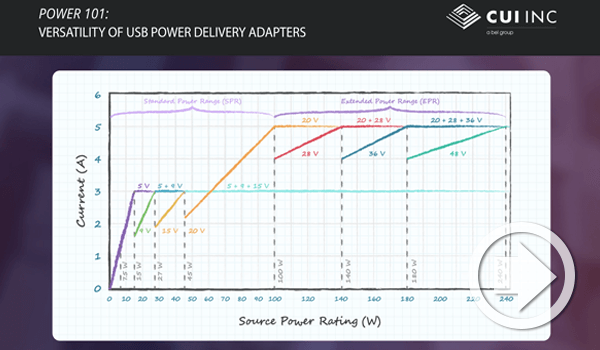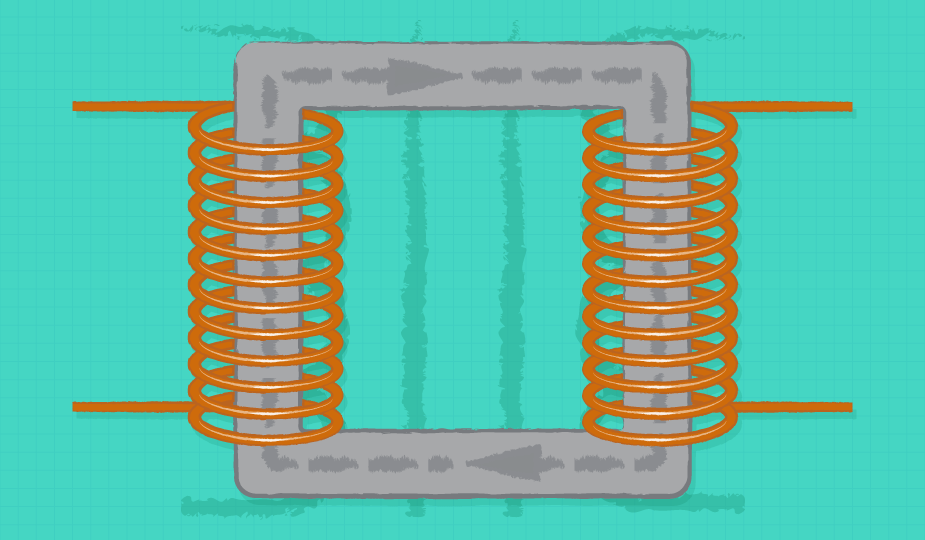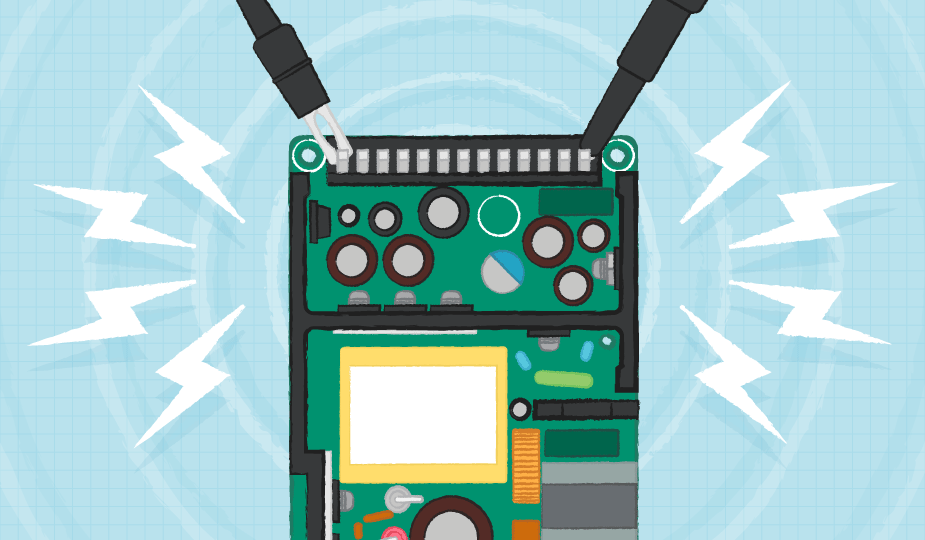USB Type-C, Power Delivery and Programmable Power Supply
May 12, 2020 by Bruce Rose - 10 Minute Read

The architecture of USB (Universal Serial Bus) has been in use as a standard for connectors and their associated signals and power delivery since 1996. During this time there have been numerous changes to the specifications to improve the performance of systems employing these standards. The latest developments applicable to power supply designs include the USB Type-C connector, USB Power Delivery specification, and USB Programmable Power Supply specification. These enhancements make USB an excellent option for delivering power, whereas in the past USB was primarily a provider of data and signal with limited power capabilities. In this post we'll discuss the relationship between USB Type-C, USB Power Delivery, and USB Programmable Power Supply, as well as how they relate to power supplies.
- USB Type-C: is a standardized USB connector; benefits include the compact, sleek, and reversible design.
- USB Power Delivery: is a specification which allows the load and power supply to negotiate for multiple standard power delivery levels. USB Power Delivery increases the power capability of USB to 100 W and is particularly useful when providing power to multiple devices.
- USB Programmable Power Supply: is a supplemental specification to USB Power Delivery describing how the load and power supply communicate for incremental power delivery levels. This feature can be particularly useful for charging batteries.
USB Type-C Connector
The USB Type-C (also referred to as USB-C) connector design is symmetrical so that it can be plugged in either way, meaning there is no right side up or upside down. This enables the plug to be inserted faster and with more ease than previous USB connector designs. With previous connector designs the user is required to visually inspect the connector to determine the correct orientation or go through a trial and error process inserting the connector; creating a mild yet all too familiar inconvenience. Another feature of the USB Type-C plug is that it has rounded edges, and this provides the benefit of a self-aligning characteristic as the plug is inserted.

The USB Type-C plug is intended for delivering moderate levels of power (less than 100 W) and the specifications associated with the small plug enables power to be delivered to a wide range of compact electronic products. One advantage of using USB connectors for power and signal delivery is that it is a sophisticated design with relativity low development costs. This is largely due to the economies of scale obtained by the wide-spread adoption of the connector at a global level. Another advantage is that the system has been validated by a large number of users and product designs, meaning that the design has demonstrated its reliability and leaves a very small probability that any unknown operating issues will arise. It is important to note that USB Type-C will typically cost more than the older generation of USB connectors due to the complexity and speed USB Type-C provides. However, as USB Type-C connectors become more ubiquitous the cost is anticipated to be adjusted accordingly.
Non-Conforming USB Type-C Applications
A designer might choose to use a USB Type-C connector, due to the sleek design, small size, and low cost, but decide to not conform to the USB Power Delivery standards. The probability of causing equipment damage with a non-conforming design will be low as long as the voltage of the non-conforming power supply is 5 V and the maximum load current specification is less than the 5 A rating of the connector. A significant risk of damaging the load will exist if a non-conforming power supply delivers an output voltage that is greater than the legacy USB voltage of 5 V.
Relationship Between USB Type-C, Power Delivery, and 3.1 Gen 2
The USB Type-C connector is closely associated with USB 3.1 Gen 2 and USB Power Delivery. This often creates confusion about the relationship between the concepts of Type-C, 3.1 Gen 2, and USB Power Delivery. It is important to note that while these concepts are related and complement one another, they are independent. A device or power supply can utilize a USB connector and not implement USB 3.1 Gen 2 or USB Power Delivery.
It is important to note that the USB protocols can be implemented with connectors other than the specified USB connectors. A customer might choose to utilize the USB data and power protocols to take advantage of the extremely large development and verification efforts already deployed by USB, but not use the USB standardized connectors in order to create a proprietary system.
USB Power Delivery
One of the objectives of USB is to maintain interoperability between conforming implementations of older and newer versions of the specifications. In previous versions of USB standards the voltage delivered was specified to be 5 V. The USB Power Delivery standard allows for the voltage delivered to be 5 V, 9 V, 15 V or 20 V and at power levels up to 100 W.
| Version | Maximum Power | Voltage | Maximum Current |
|---|---|---|---|
| USB 2.0 | 2.5 W | 5 V | 500 mA |
| USB 3.1 | 4.5 W | 5 V | 900 mA |
| USB BC 1.2 | 7.5 W | 5 V | 1.5 A |
| USB Type-C 1.2 | 15 W | 5 V | 3 A |
| USB PD | 100 W | 5/9/15/20 V | 5 A |
USB Power Delivery establishes operating protocols to ensure that the higher voltage available in the recent USB releases does not damage legacy equipment which was designed for 5 V operation. In order to prevent such damage, the USB Power Delivery requires conforming equipment to initially deliver 5 V at maximum 900 mA to the load. Communication between the load and the power source can then establish a higher maximum load current and greater operating voltage. If no communication ensues after connecting the load and the power supply then the power supply configuration remains at 5 V and 900 mA maximum load current capacity. If communication between the load and the power supply is lost after it has been established then the power supply will safely revert back to the 5 V and 900 mA configuration.
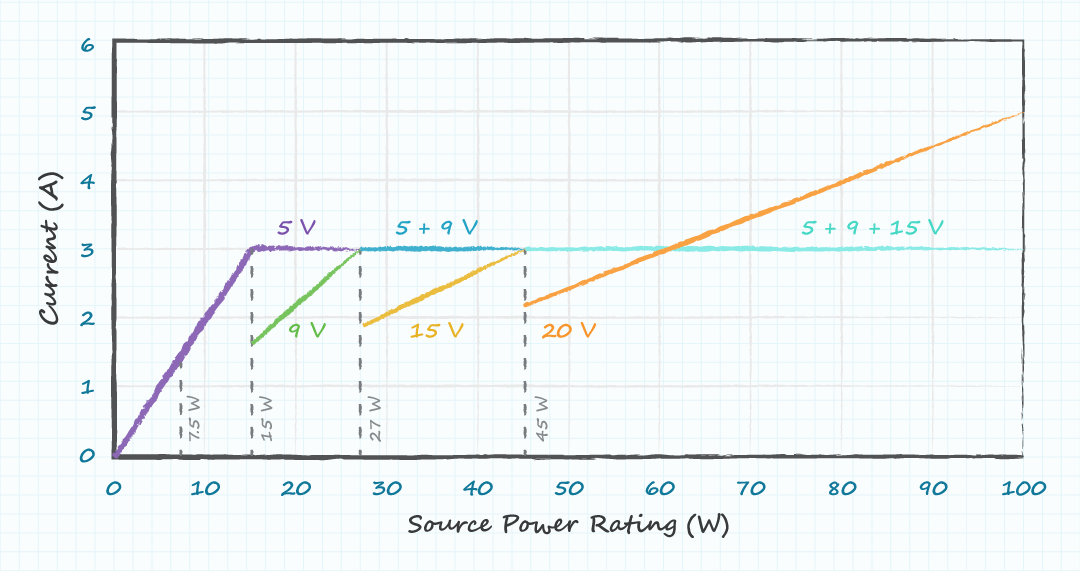
USB Power Delivery Applications
The advantage of USB Power Delivery to create a single power source that can be used to provide power for multiple products will be of greatest benefit when the products are sophisticated and expensive. An example of an application for USB Power Delivery is a power source that is used to charge cell phones, laptops, tablets, smart watches, and ear buds. All of these products are sufficiently sophisticated such that the added cost and complexity to communicate with the power source is acceptable. In addition, the user may be in a vehicle, a room, an office, or traveling where they would expect to have power provided for those devices, but the mix of the different power loads would be difficult to predict. In these scenarios, USB Power Delivery power sources would negotiate with each device to provide the proper voltage and current configuration as required by that load.
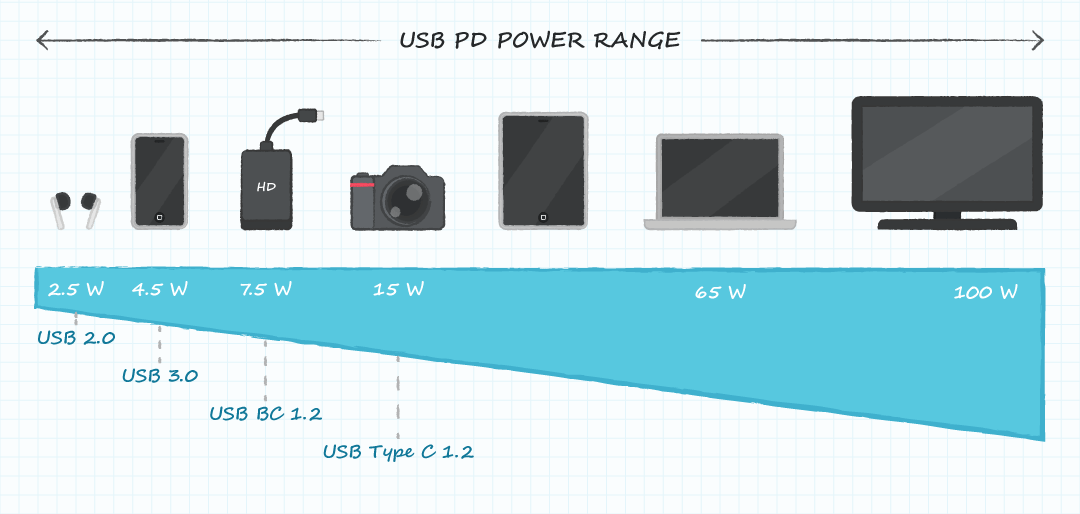
While the claims that USB Power Delivery will enable more rapid battery charging are not wrong, they may be misunderstood. The time required to charge a battery is limited by the construction of the battery and by the power delivery capability of the power supply. Implementing USB Power Delivery will shorten the time required to charge a battery if the charging of the battery was limited by the power delivery capacity of the charger and not by the battery construction. USB Power Delivery will not reduce charging time when compared to a fixed output power supply when the power output capacity of both sources are the same.
Products which may not be good candidates for USB Power Delivery are those which are less complex and less expensive with relatively low power requirements. Less expensive products may not be able to absorb the design and manufacturing costs due to the USB Power Delivery capability being built into the device in order to communicate with the power supply. In most applications where a power source is selected to provide power to a load, the power source capacity will be selected only as what the load requires. If a higher capacity power source were specified then the excess capacity in the power source will cause the size and cost of the power source to be greater than required. The power delivery capacity of a USB Power Delivery source must be designed to deliver the maximum rated power of the configurable source. A system with a light load which could be powered by either a USB Power Delivery source or by a smaller power delivery source will incur a cost and size penalty to use the USB Power Delivery source.
USB Programmable Power Supply
The USB Programmable Power Supply protocol provides for greater power delivery control than both legacy and USB Power Delivery protocols. While the USB Power Delivery operating protocol governs how USB power supplies deliver discrete voltage levels, the USB Programmable Power Supply operating protocol establishes the ability to control the output voltage and current characteristics of the power supply at a granular level.
USB Programmable Power Supply Applications
A common application requiring granular control of voltage and current, as offered by USB Programmable Power Supply, is the charging of batteries. In a conventional battery charger topology a voltage supply is applied to a battery charge control circuit and the output of the system provides the proper voltage and current to charge the battery. This works well when the battery charging voltage and current characteristics are standardized and thus the battery charging circuit can be a standard design. For applications where a customized voltage and current charging profile is required for the battery then a USB Programmable Power Supply may be a better solution. With a USB Programmable Power Supply power source the load will monitor the status of the battery and provide commands to the power source such that the battery is charged with the correct voltage and current profile. It should be noted that when a USB Programmable Power Supply configuration is used for battery charging the development team will be required to design, implement, and test the battery charging algorithm and circuits whereas when a standard battery charging circuit is selected the vendor of the battery charging circuit has completed most or all of those tasks.
Conclusion
The USB Type-C connector and USB Power Delivery specification provide significant enhancements to the USB standards. While implementing the complete standard will allow for greatly enhanced systems, significant benefits can also be realized with the implementation of only parts of the new standard and protocol. It is expected that the USB Type-C connector will be used in many traditional 5 V power delivery applications with load current requirements of 5 A or less due to the small size, improved design, and low cost of the connector.
Industry News , Product Selection
You May Also Like
Have comments regarding this post or topics that you would like to see us cover in the future?
Send us an email at powerblog@cui.com
